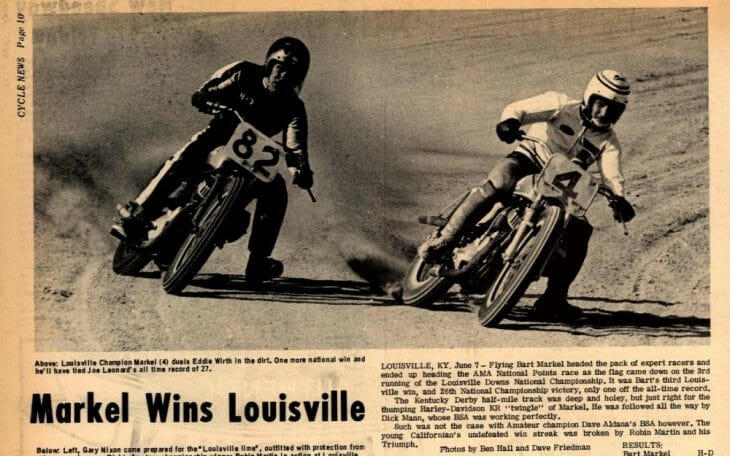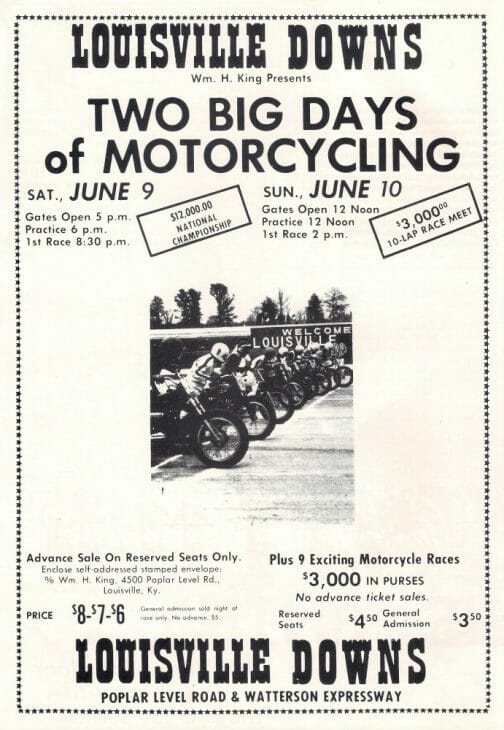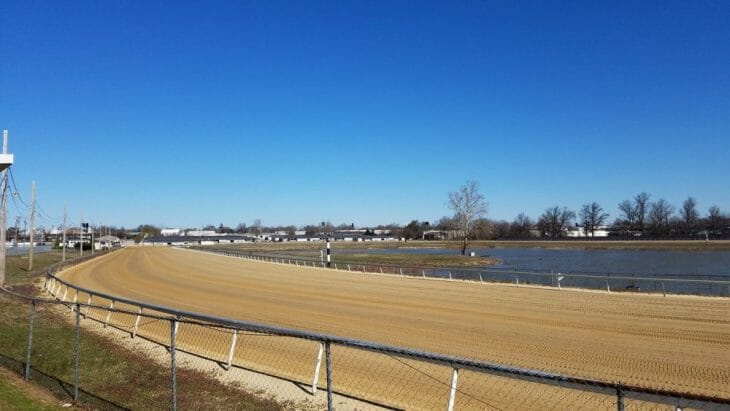Larry Lawrence | March 29, 2017

Flat track fans of a generation ago often talk of the AMA Grand National races at the old Louisville Downs as some of the most memorable in series history – for both good and bad. The track was famously the site of the legendary Jay Springsteen’s very first national win. It was also infamous for the tragic incident in May of 1980 incident where David Jones (brother of racing legend Ronnie Jones) was killed when he collided with a spectator who had walked onto the track. Triumph and tragedy both played a part in Louisville Downs making an indelible mark on the sport of flat track during its 25-year run from the late 1960s to the early 1990s.
The Half-Mile Standardbred racing facility was built in July of 1966 on the south side of Louisville, Kentucky. Less than a year later the track hosted its first national motorcycle race on June 11, 1967. When it began, it was the AMA National 15-Mile National, in the days when events were still ran at differing lengths. The 15-mile National had previously been held at Pennsylvania’s Heidelberg Raceway, but that track was paved opening up a slot for the newly-completed Louisville Downs. The inaugural race did not get off to a flawless start, with some complaining the facilities weren’t yet up to par to host a national. Yet in spite of some rough edges, the one thing Louisville Downs had, and would be a constant throughout its 25 years, was its unique ankle-deep white crushed limestone racing surface.
The soft cushion track made for spectacular broad slides through Louisville Downs’ broad and ultra-wide turns. Riders could run four wide with all four in a full-lock slide. That style of track played right into the hand of classic cushion specialist Bart Markel. It was Markel who scored victory in that first national in 1967 – over Chris Draayer – and the Harley-Davidson factory rider would dominate the event in its early years.

Markel won again at the ’68 Louisville Downs National after a race-long tussle with Dan Haaby. In fall of that year ABC Wide World of Sports filmed an invitational race at the track that event would continue for better than another decade. The race featured a head-to-head meet with all the national winners of the season. That made-for-TV race, with riders running full out in big arching slides through the turns, was a great spectacle for Wide World of Sports, further solidifying the national reputation of Louisville Downs.
“ABC’s popular Saturday afternoon sports program “Wide World of Sports” hosted a segment taped on Sunday after the National event in ’70,” remembers William Field. “As part of an opening montage, we were all asked to line-up our helmets on top of the inside railing. A hundred Bell helmets of all colors glistening in the sun made for a dramatic opening image. The tape delay broadcast was shown about six weeks later. Being on TV back then was a big deal. I was surprised the following Monday morning to find out how many fellow high school students saw their classmate on the boob tube!”
By 1970 the bugs were worked out and that year a standing room only crowd witnessed the smoothest Louisville on record and Canadian Dave Sehl breaking Markel’s stranglehold on the race. Rains for days leading up to the national packed the fine limestone allowing riders to race full lock around the corners with their feet on the pegs. The only problem was the thick, sticky limestone shot up a powerful roost that would pulverize trailing riders. David Aldana took to keeping his right hand full twist on the throttle through the turns, while his left hand was wiping dirt from his face shield!
Sehl would go on to match Markel’s record of three Louisville wins in 1973.
It was 1975 when a young Jay Springsteen broke through to score his first national victory. He did it in spectacular fashion. ‘Springer’ vividly remembers his first AMA Grand National victory at Louisville Downs.
“Corky Keener had won it the year before riding up high in the cushion,” Springer remembers. “I decided to ride the cushion that night and by the final there was just a small cushion way up by the hay bales. Everyone else rode low on the groove and somehow I found a way to make it work up high, clipping the bales in the corners and just sort of ran away with it.”
It was Springsteen who would finally breakthrough in 1979 to become the first four-time winner at Louisville. He would win it one more time in 1983 to end up with five, the most Louisville Half-Mile wins in the quarter-century history of the race.

Everything was going great at Louisville through the 1960s and the ‘70s. But then came the tragic 1980 race. A spectator jumped a chest-high guardrail during a Heat race and walked onto the race track, reportedly waving a whiskey bottle. Six riders swerved to avoid him, but David Jones had no place to go. He hit the spectator sending both horrifically tumbling down the track. Jones, who was just 18, died that night. The spectator never left the hospital and passed away a month later.
Jimmy Filice won his first Grand National as a rookie on the Roberts/Lawwill team in 1981.
Perhaps one of the most famous races in Louisville came in 1982. It was an historic win.
Honda had won national road races, Short Tracks and TTs, but Scott Pearson’s ’82 Louisville victory marked Honda’s first win on a big track in AMA Grand National competition. And Pearson did it on the underdog Honda NS750, the flat track machine based on the water-cooled Honda CX500 production machine. It was a highly unlikely victory on a machine that no one had been able to make work.
“Louisville had a real wide straightaway, so everybody got a front row,” Pearson said. “We lined up for the start and I looked and for whatever reason nobody took the lowest line, and I thought ‘Ooh perfect!’. It was all cushiony and still wet down there and lots of traction. I got the holeshot and I rode my race and did a little blocking along the way and pulled it off.”
National continued at Louisville Downs until 1991. They might have continued on, but the track closed and was bought by nearby Churchill Downs and was converted to a winter training facility for thoroughbreds.
To this day there’s a lot of mystery about the status of the track. Many believed the land was developed, but the fact is the track is still there. The grandstands are gone, but the track which last hosted motors 26 years ago, sits there ever so inviting. When I visited, my dream would have been to have riding gear, a steel shoe and an XR – and oh yeah, a day pass.